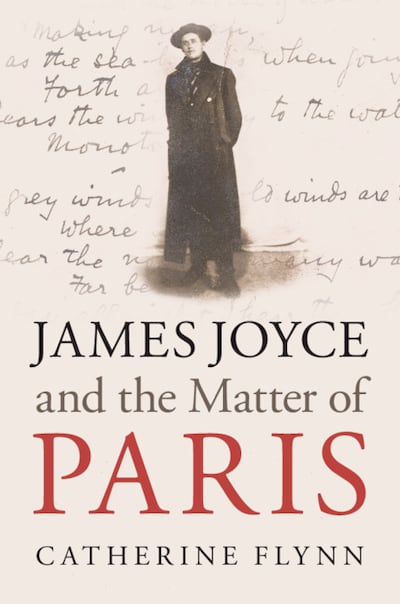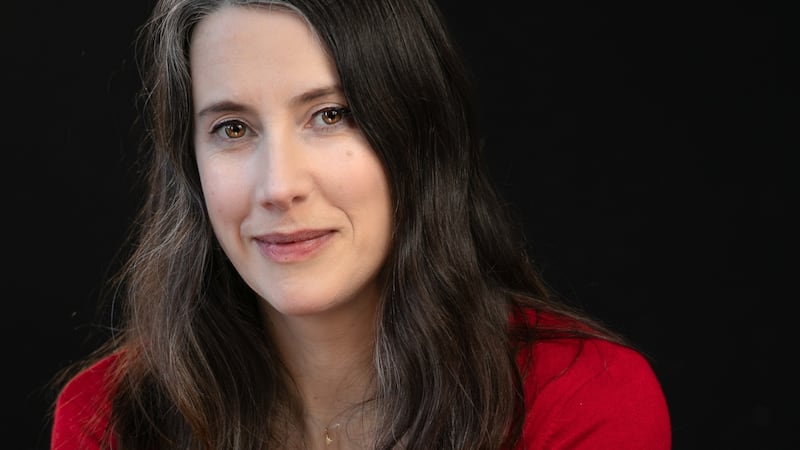In 1902, in Paris, a thin, uncertain James Joyce posed for a photograph in borrowed Left Bank clothes. This image is the starting point for the new account my book offers of this most canonical of Irish modernists.
Twenty years old, Joyce had moved to the City of Light in an attempt to join the poètes maudits, “accursed poets” like Paul Verlaine and Charles Baudelaire. He was too late, the poets had passed on, and after a few months in the city, at the news of his mother’s fatal illness, he returned to Dublin. But Joyce was profoundly shaped by his early encounter with Parisian life and Parisian literature. The French metropole posed a question that motivated his work for the rest of his life: what, given the force of modern capitalism, is art?
This question emerges in the notebook Joyce kept in Paris in 1903 (and took with him when he eloped with Nora in 1904). The notebook, which the National Library of Ireland made available online in 2002 as part of the James Joyce Papers, is strikingly modest: a French schoolboy’s cahier with graphed pages. It allows a glimpse into the mind of the young Joyce, as he records the dates he studied at the library and lists his expenses and borrowings side by side with quotations from Aristotle and questions on aesthetics.
The notebook shows that these concerns were intimately related for Joyce: his accounting and his research were allied attempts to master the overwhelming demands of the city around him. In this notebook, Joyce wrote an essay on aesthetics that declares that “proper” art excludes desire and loathing. Readers of A Portrait of the Artist as a Young Man are encouraged to see the essay as the composition of a Stephen Dedalus walking through the streets of Dublin. Yet the notebook shows that it is a response to a city in which everything offered itself for sale.
The essay was only one of Joyce’s contradictory reactions to Paris. He had his Left Bank photograph printed on three postcards that he sent home to his family and his friends, John Francis Byrne and Vincent Cosgrave. The postcard to his family expressed concerns about his finances and job prospects, as many missives home from twenty-year-olds do. The two postcards to his friends were radically different: the postcard to Byrne featured a poem on the “journeyings of the soul” that takes the perspective of a bird flying alone over restless waters; the one to Cosgrave offers a description in dog Latin of streetwalkers that was described by Richard Ellmann in his biography of Joyce as “scatological” (this postcard is currently lost). Joyce’s dissimulation, when it was revealed, cost him his friendship with Byrne.

Joyce’s failure to develop a coherent response to the city led him to compose the aesthetic essay but he also developed a more complex response in a description of women on a Parisian street. The short piece augurs the erotic content Joyce went on to mine to such famous effect. If the piece’s observer attempts to present the women in objective terms as shallow, materialistic, and calculating, the piece itself undermines such objectivity with the intrusion of the olfactory sense: “They pass in an air of perfumes: under the perfumes their bodies have a warm humid smell.” This smell, ambiguous, intimate, and human, crosses the gap between observer and observed, revealing their shared bodily condition. The description thus presents the city as an environment of judgment and exchange but also as a place where the human body resists these calculations and offers the possibility of other experiences.
Joyce’s notebook reveals these possibilities to be grounded in a philosophical study that ranges from Aristotle, through Aquinas, to Hegel. His subsequent work explores these possibilities as he develops an aesthetics of the body. In devising this art of sensual experience, Joyce adapts innovations by French writers of the late 19th-century, who were themselves struggling to develop ways to respond to the sensory impact of the city. Joyce’s short but carefully wrought description of the encounter on the boulevard is a version of the new urban form Charles Baudelaire called for: “Who among us has not, in his moments of ambition, dreamed of the miracle of a poetic prose, musical, without rhythm and without rhyme, supple enough and rugged enough to adapt itself to the lyrical movements of the soul, the undulations of reverie, the sudden starts of consciousness? It was above all out of the exploration of huge cities, out of the intersection of innumerable interrelations, that this obsessive ideal was born.” In fact, when Joyce met WB Yeats in 1902 before setting off for Paris, he asked him to read some of his prose poems and he announced his writerly ambitions in terms that echo closely Baudelaire’s words.
Baudelaire was one of the first of a series of French writers on whom Joyce drew throughout his career. My book traces these moments of literary adaptation as Joyce attempts to devise a form to give voice to experience in the ville énorme. Stephen Dedalus’s sensual encounter with Emma Clery at the end of Portrait adapts the first lines of Arthur Rimbaud’s sonnet, Voyelles: “A, black velvet corset of sparkling flies/ That hum around cruel stenches/ Gulfs of shadow.” In Ulysses, Leopold Bloom’s musings on the streets of Dublin take the form of the interior monologue devised by Édouard Dujardin in Les Lauriers sont coupés, a short and less than successful novel about a man consumed by consuming. Bloom’s hallucinatory wanderings in the Mecklenburg Street red-light district in the “Circe” chapter of Ulysses rework the visionary literature of Gérard de Nerval and Rimbaud. The absurdist and scatalogical language of Finnegans Wake develops the philosophie de merde conceived by Alfred Jarry, the avant-gardist whose play Ubu Roi caused a riot in 1906.
If Joyce can look strange alongside his fellow English-language modernists, this array of sources shows him to be at home in a French milieu. This is not to say that Joyce was uninterested in Irish literature or politics: his work is capacious enough to contain multiple concerns and commitments. While early scholars tended to see Joyce as an apolitical cosmopolitan, and a subsequent wave of theorists turned to his works to illustrate their philosophies, scholarly work in recent decades has traced the impact of Irish politics on his writing. My book offers a new departure by arguing that Paris gave Joyce a lens through which to see his native city as a modern urban environment. It opened his eyes to powerful forces that were working in insidious ways in the Irish capital, in the form of an encroaching mode of exchange that threatened to deform all interpersonal relations.

In grappling with these issues, Joyce’s work illustrates the power of literature as social critique and counterforce. His writing impacted on his French contemporaries in crucial ways that have gone unnoticed. In 1920, he returned to the city with Nora and his children Giorgio and Lucia, intending to stay for three months but remaining there until the outbreak of the war in 1939. He moved in the literary and artistic circles around the Shakespeare and Company bookshop owned by Sylvia Beach, who was the first to publish Ulysses.
It was in this milieu that he met the young writer Louis Aragon who was inspired by the “Circe” chapter to write the first Surrealist novel, Paysan de Paris, or Paris Peasant. Aragon’s novel in turn prompted the Frankfurt School theorist Walter Benjamin, then resident in Paris, to begin his Passagen-Werk or Arcades Project, a huge study of the impact of capitalism on the city. Aragon’s and Benjamin’s works develop in different ways Joyce’s exploration of the capacity of sensory experience to resist the pressures of capitalism and to lead to an awareness of social truths.
Joyce wrote at an early moment in the burgeoning of consumer capitalism; the issues he grappled with are all the more pressing today, as the influence of transaction and exchange has only intensified. His use of verbal art to explore sensory experience is certainly challenging to us but it is this very challenge, this refusal of straightforward speech, that is the work’s important resistance to the streamlining of language in the furtherance of transactional relations. Joyce’s words and his innovative literary forms open up a space in which we can reflect on the modern world and on our experiences in it.
James Joyce and the Matter of Paris by Catherine Flynn is published by Cambridge University Press, price £25.99










